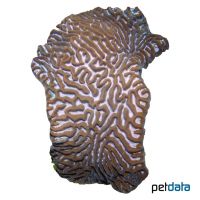Lesser Valley Coral (LPS) (Platygyra acuta)
| Lesser Valley Coral (LPS) Platygyra acuta | |
|---|---|
| Name | Lesser Valley Coral (LPS) |
| Name Lat. | Platygyra acuta |
| Family | Merulinid Corals |
| Family lat. | Merulinidae |
| Order | Stony Corals |
| Order lat. | Scleractinia |
| Origin | Indo-West Pacific, Red Sea |
| Diet | Autotrophic, planktivore |
| pH | 8.1-8.4 |
| Hardness | 8-10 °KH |
| Lighting | Medium-high |
| Current | Moderate-strong |
| Behavior | Semi-aggressive |
| Keeping | Colony |
| Care Level | Moderate |
| Life Span | N/A |
| Protection | CITES Appendix II; EC Annex B |
| Metric Units | |
| Size | < 30 cm |
| Temperature | 22-28 °C |
| Salinity | 33-36 ‰ |
| Aquarium | 200 l |
| US Units | |
| Size | < 12" |
| Temperature | 72-82 °F |
| Salinity | 1.020-1.025 sg |
| Aquarium | 50 gal |
Distribution and habitat
Platygyra acuta belongs to the group of LPS (Large Polyp Scleractinia). This reef-building coral is widely distributed in the Red Sea and tropical Indian Ocean, as well as in the Western Pacific. They live on reef tops and reef slopes, except in the surf zone, where they occur in various colors and growth forms down to 30 m depth.
Maintenance
They should be positioned in a place with higher light intensity and moderate to strong, alternating current. Only high-calcium, heavy metal-free substrates should be used as substrate. Filters, skimmers and heaters are necessary to ensure water quality, as well as pumps to simulate tides, swells and bottom currents. It is recommended that live stones be used to set up the aquarium. The bacteria living in the porous stones act as a biological filter. The lighting must correspond to the species-appropriate day-night rhythm of the animals
| Salinity: 33-36 ‰ | pH value: 8.1-8.4 |
| Carbonate hardness: 8-10 °KH | Nitrate content: 2-8 mg/l |
| calcium content: 420-450 mg/l | Nitrite content: 0.0-0.05 mg/l |
| Magnesium content: 1.250-1.350 mg/l | phosphate content: 0.01-0.1 mg/l |
Regular addition of trace elements, especially calcium and strontium, is recommended. For salinity, an average value should be aimed for, which may only vary slightly by +/- 0.5 ‰. Ammonia and ammonium must not be measurable. Special attention shall be paid to consistently good water quality and water values.
Diet
Zooxanthellae, which are unicellular symbiotic algae, live in their tissue and provide them with assimilation products of their photosynthesis (high light requirement). The zooxanthellae promote growth and provide additional food to the plankton and small particles that are collected in large quantities from the water current. Thus, in addition to the food produced during fish feeding (mysis, krill, Artemia, etc.), commercially available supplementary food in the form of phyto- and zooplankton should be offered regularly
Regular and varied feeding promotes good health.
Behaviour and compatibility
They should not be kept with fish that regard their polyps as food (e.g. angelfish or butterflyfish). They are well tolerated with other corals, but sufficient distance must be kept from cnidarians.
Reproduction and breeding
In nature, reproduction is sexual via marine larval stages. In the aquarium they can be reproduced conditionally by fragmentation. Fragments are fixed in the reef structure, e.g. with a good two-component coral glue (epoxy).
Species protection
Species protection: WA Appendix II; EU Appendix B. The proof of purchase is the required proof of origin for the animal. Please keep it safe! Your pet store will be happy to provide you with further information.
Important
These fast growing corals form massive or overgrowing colonies with meandering surface. The additional illumination with actinic light (short-wave, violet-blue light) is very beneficial for their growth (zooxanthellae). For the necessary uniform supply of calcium carbonate and magnesium, a calcium reactor and a magnesium metering pump are recommended. Too high temperature, insufficient lighting or current as well as sudden change of water values can lead to tissue decay (RTN - rapid tissue necrosis). They are very sensitive and can be easily injured during handling. Newly introduced animals must be acclimated slowly to the water in the aquarium
If different species are kept together, make sure that fish and invertebrates match each other in terms of water quality and temperature requirements, as well as their social behavior, and that the setup meets the ecological needs of all species kept together
Further literature can be found in your pet store.
References
Text: petdata; Image: petdata
Source: ENGELMANN & LANGE (2011): Zootierhaltung - Tiere in menschlicher Obhut: Wirbellose, Verlag Harri Deutsch; VERON (2000): Corals of the world, Australian Institute of Marine Science
